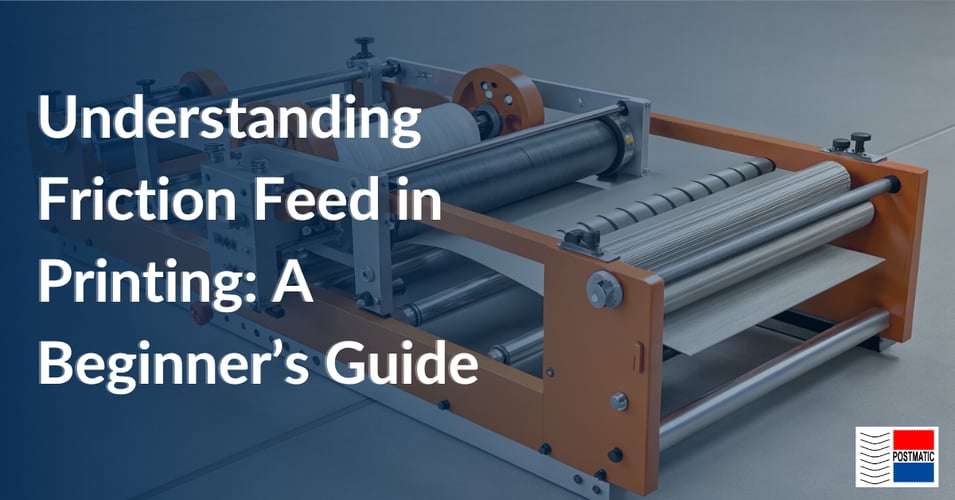Understanding Friction Feed in Printing: A Beginner’s Guide

Table of Contents
When it comes to printing technology, efficient handling of materials is essential. If you're new to the field, one of the first concepts you’ll encounter is friction feed. This method of paper handling systems ensures smooth and reliable printing operations, a crucial aspect of producing consistent results on various materials. Here, in Understanding Friction Feed in Printing: A Beginner’s Guide, you’ll learn what it is, how it works, and why it’s an excellent choice for those just starting out.
For a deeper understanding, be sure to check out our detailed Pillar Page on this topic. Let's break it down step by step to make sure you’re well-equipped to use this technology effectively.
What Is Friction Feed in Printing?
Friction feed is a system used in printing technology to handle paper or other materials with precision. It works by utilizing rollers or belts to grip and guide the material through the machine. The purpose of friction feed is to ensure that sheets are fed one at a time into the printer, preventing overlaps or jams.
Unlike gravity feed or pneumatic systems, friction feed relies on contact between the material and the feed mechanism. It’s commonly found in desktop printers, office copiers, and mailing systems. Beginners often find friction feed systems easy to understand and operate, thanks to their straightforward design and dependable performance.
How Friction Feed Works
To appreciate the mechanics of friction feed, think about how a conveyor belt system moves items. At its core, a friction feed system uses rollers and belts with frictional surfaces to grip and move materials like paper. Here’s a quick breakdown of the process:
- Feed Rollers and Friction Materials: The machine is equipped with rubber rollers designed to provide traction. This grip ensures a single sheet of paper is picked up at a time.
- Separation Mechanisms: Friction and precise alignment prevent multiple sheets from entering the feed path simultaneously.
- Transportation: Once the sheet is gripped, it’s guided through the printer for further processing, like applying ink or toner.
This precise mechanism reduces errors, such as paper jams or feeding multiple sheets at once, making it a favorite for beginners in printing technology.
Advantages of Friction Feed for Beginners
For those new to printing operations, starting with a friction feed system offers several benefits:
- Ease of Use: These systems are intuitive and user-friendly, making them ideal for beginners.
- Reliability: With simpler designs and fewer parts than some advanced feed systems, friction feed mechanisms are less prone to mechanical failures.
- Adaptability: Whether you’re working with plain paper, cardstock, or lightweight sheets, friction feed handles a diverse range of materials effectively.
For example, imagine printing wedding invitations on specialty paper. A friction feed system can manage these non-standard sizes and textures with precision, ensuring each piece looks perfect. Additionally, by acquainting yourself with common operational tips, like cleaning the feed rollers regularly, you can avoid frustrating errors like paper jams.
Common Applications of Friction Feed Technology
You may now be wondering where friction feed technology is most impactful. It’s widely used across various devices and industries, including:
- Printers and Copiers: Whether in home offices or business settings, friction feed systems are essential for smoothly handling different materials.
- Mailing Systems: Bulk mail operations often rely on friction feed mechanisms to insert and move envelopes with speed and accuracy.
- Bespoke Printing Services: Projects like brochures, flyers, and personalized prints frequently employ friction feed systems for compatibility with specialized media.
That being said, friction feed technology does have limitations. For example, it may struggle with materials that are too thick or slippery, where other systems like vacuum feeds might perform better. Still, its versatility and reliability make it a popular choice for most everyday printing operations.
Conclusion
Understanding how friction feed works is crucial for ensuring smooth, efficient printing operations, especially if you’re just stepping into printing technology. This fundamental system operates by using friction to guide and feed paper seamlessly through printing machines, ensuring high reliability and consistency. Its ease of maintenance, reliability, and adaptability make it an excellent choice for beginners and experienced users alike, offering simplicity without compromising performance.
If you’re ready to explore its potential further, learn more about friction feed technology and its benefits by visiting our detailed guide. Have questions or need help finding the right system for your application? Contact us at info@postmatic.net or call (651) 407-3100 — we’re here to help you master the basics of reliable paper handling systems.






